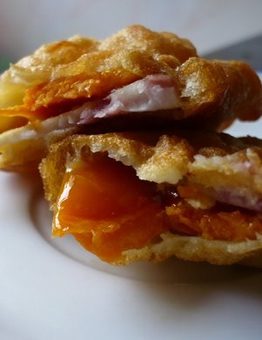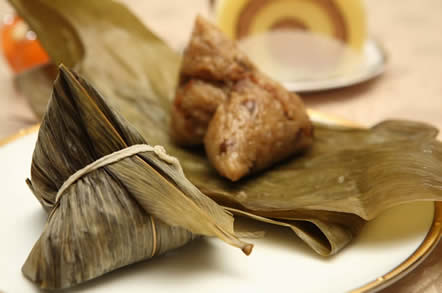Wendy J. Gu
Philadelphia, Pennsylvania, USA
 |
| Nian gao may be deep fried for New Year’s Day |
Rice, noodles, breads, buns, and pancakes all appear in traditional Chinese cuisine, but white rice is the ultimate staple. It can be found at all meals, from breakfast to dinner to dessert, in various guises and preparations, but it is overwhelmingly consumed in its simplest state—steamed. In Chinese cuisine, the savory meat and vegetable dishes require plain white rice to balance the flavors and textures of the entire meal. This traditional culinary staple is not without risks however. A recent study from Harvard published in the Archives of Internal Medicine showed that consuming white rice regularly more than five times per week increases the likelihood of developing type 2 diabetes by nearly twenty percent. It is therefore not surprising that type 2 diabetes has become increasingly prevalent in the United States among all ethnic minorities, especially among Chinese Americans, who account for the largest subgroup among Asian American populations.
Despite obesity levels that are lower among Asian Americans compared to European Americans, the incidence of insulin resistance leading to type 2 diabetes is double among Chinese Americans, suggesting a predisposition to developing this chronic disease.1 Chinese American patients also consistently find diet to be the most difficult area of change, even though replacing one third of a serving of white rice with brown rice on a daily basis reduces the risk of type 2 diabetes by sixteen percent.2
To understand the difficulty that these patients have modifying their diet, one must realize that food plays a significant role in the lives of Chinese Americans. Meals are an important cultural activity because they are enjoyed and valued, not just on an individual basis, but on a social one.3 These days, the family dinner may be considered the most meaningful meal, as it is the one moment of the day that parents and children can share as a family after the obligations of work or school. But simply understanding the historical, cultural, and linguistic implications of rice will shed some light on this dietary staple and reveal ways for healthcare providers to help their patients improve their health.
Historically, rice was eaten more in southern China, since the warmer climate allowed for its development and cultivation of rice. Archaeological evidence of rice planting in China has been dated to as early as 3,000 to 4,000 years ago. By the Zhou Dynasty (1100–771 BC), rice was an important part of the aristocratic diet. During the following Spring and Autumn Period (770–476 BC), rice had become well established in the daily diets of common people.4 As rice cultivation advanced and methods were standardized during the Han Dynasty (206–220 AD), rice became ingrained in China’s socioeconomic structure and culture.5
Anthropologists have sometimes called Chinese culture a “rice culture,” reflecting the integral intertwining of rice with the development of thousands of years of Chinese culture. Prior to the Qin Dynasty (221 BC–206 BC) when rice became readily available, it was a special food used as offerings to deities, for brewing wine, and as an ingredient in dishes made to celebrate or commemorate holidays.4 Even in the present day, these rice specialties are still made and eaten on special holidays, the most important of which is the Lunar New Year’s Eve dinner. Rice cakes called nien gao are eaten; and, while they may differ in preparation method or form depending on the regional cuisine, they are consistently consumed because gao is also a homophone for the word meaning “high.” Eating nien gao during the new year signifies hope of reaching greater heights and bettering one’s future. Another custom that takes place fifteen days later, when the first full moon of the New Year appears, is eating small rice dumplings called tangyuan with one’s family to signify togetherness for another year. This special day is also known as Yuan Xiao jie, or the Lantern Festival.4
 |
| Dragon boat racing in Richmond, Canada |
Another popular festival that involves rice, well-known in the United States as well as China, is the Dragon Boat Festival, which occurs on the fifth day of the fifth lunar month (usually late May or early June), and is known as Duan wu jie (literally “double fifth festival”).4 In addition to racing dragon boats, zongzi are eaten; these are made by forming glutinous rice into pyramid shapes filled with small bits of meat, mushrooms, and chestnuts, which are wrapped with banana leaves, tied with string, and steamed. This holiday commemorates Qu Yuan, a great statesman and poet of the Warring States period (475–221 BC) who committed suicide as he despaired over the conquering of his state, Chu, by the state of Qin.6 The story most often told is that the people of his village, who valued his patriotism and wisdom, raced out on their fishing boats to try and save him, giving rise to the popular tradition of racing dragon boats. The origin of the zongzi, however, is more varied. In one story, the villagers threw rice into the river so that the fish would leave Qu Yuan’s body alone, but seeing the rice float near the surface, they rolled the rice into balls and wrapped them in leaves to help them sink. Another story has the villagers throwing rice into the river as an offering to Qu Yuan’s spirit so that he would not starve as he made his way through the afterlife. Today, zongzi are usually available year-round in Chinese markets, not just during Duan wu jie.
Several other festivals that are less known in the United States but that are still celebrated in China and Taiwan involve foods made from rice, glutinous rice, or rice flour. For Chinese Americans however, the Lunar New Year, the Lantern Festival, and the Dragon Boat Festival are the holidays involving special foods made from rice that are most popular. Yet, on a daily basis, steamed white rice remains an essential part of the Chinese American diet. There is a saying that “a meal without rice is like a beautiful woman with only one eye”; children are warned to finish their rice at meals, lest their future spouse have an unsightly pockmark on their face for every uneaten grain of rice.7
Linguistically, there are many subtleties in Mandarin Chinese for the word “rice.” Using the pinyin system of Romanization, with the numbers 1 through 4 representing the four tones of Mandarin, the nuances may be seen as follows8:
| Dao4 | The rice plant |
| Dao4-gu3 | The whole grain of rice, with husk intact |
| Kang1 | The chaff surrounding each rice grain |
| Mi3 | Uncooked white rice |
| Fan4 | Cooked white rice. Also means “food” in general, thus revealing the significance of rice as a staple in the Chinese diet. |
| Cao1-mi3
Cao1-mi3-fan4 |
Uncooked brown rice
Cooked brown rice |
| Zhou1
Xi1-fan4 |
Rice porridge (aka congee)
Literally, “thin watery rice.” These two terms are synonymous; their usage is a regional difference. |
| Nuo4-mi3 | Glutinous rice (aka “sticky rice”) |
Rice vocabulary in Mandarin Chinese
The most relevant point to note in this table is the dual definition for the word fan4, which means both “rice” and “food.” Thus, rice is such an essential component of the Chinese diet that when patients are told to eat less white rice, they generally understand this to mean “eat less food.” Unless an adjective is used to specify white rice (bai2-fan4), patients are incorrectly told—and incorrectly infer—that they must consume less food overall. Herein lay the first obstacle in communicating the need for dietary changes to Chinese American diabetics. Accurate translation and understanding the dual meaning of the Chinese word for rice is necessary to help patients make the correct changes to their diet. Another important barrier to understanding the necessity of altering white rice intake is the fact that the Chinese translation for this diabetes is “sugar urine disease.” As such, many patients believe that eliminating sugars and sweets from their diet will be sufficient to control their disease, without realizing that carbohydrates need to be carefully controlled.9,10
Aside from having access to trained medical interpreters to avoid miscommunication, clinicians need to frame managing diabetes in a way that is compatible with their patient’s culture, especially when it comes to diet changes. Having considered the extensive history of rice and its importance in Chinese culture, one can understand why these patients have such a hard time eating less rice. In the Chinese American diet, rice is akin to bread or pasta in the Western diet, but to a more essential degree; Chinese cuisine, regardless of region, is constructed so that each vegetable or meat dish, which would otherwise be considered an entrée, is actually an accompaniment to rice. To the Chinese palate, these dishes are too savory or too heavily sauced to be eaten without a plainer “base,” such as rice, to create the perfect balance. Historically, rice became the heart of Chinese cuisine because vegetables and meat were not always readily available. Rice was more abundant and was therefore a better source of energy, thus becoming the bulk of the diet. Even a 2007 study of middle-aged Chinese women in Shanghai showed that white rice consumption still accounted for 53.7% of total energy intake. 11
 |
| Savory zongzi are eaten during Duan wu jie to commemorate Qu Yuan |
At the Chinatown Clinic in downtown Philadelphia (a weekly free clinic run by Drexel College of Medicine physicians, students, and diabetes nurse educators who see mostly uninsured recent immigrants from China and Indonesia), diabetic patients are advised to substitute their white rice with brown rice. Some patients immediately express their preference for white rice because it is more fragrant and palatable than brown rice. We often tell them that they can cook a mixture of brown and white rice in their rice cookers instead. Other patients have reported difficulty finding brown rice in the Chinatown markets, which is surprising. But we learned that until recent decades, brown rice was less commonly available at Asian markets in the United States. A number of possible explanations include the previous association of brown rice with poverty, especially during wartime or in poor rural communities where rice remained unpolished.
Popularity of brown rice has grown, however, as more people are aware that stripping the grains of their husks during the refining process removes certain vitamins and minerals while increasing the glycemic index.12 Brown rice is actually considered a whole grain; therefore, recommending that it be substituted for white rice would serve a nutritional benefit in all rice consumers, but especially in diabetic patients.2 When this was explained to the clinic patients, they were more eager to incorporate brown rice into their diet because as one patient said, “it is healthier and better for your body.”
The dilemma of white rice is perhaps the most frequently encountered obstacle when helping Chinese American diabetic patients make appropriate carbohydrate exchanges. Physicians and nurse educators should be aware that direct language translations such as “eat less rice” are not helpful because patients misunderstand the translation to mean they should eat less food, as discussed above. Furthermore, culturally appropriate recommendations are more likely to be adopted by patients when they fit their cultural frame of reference. For example, the Chinatown Clinic acquired a food pyramid specifically modified for the Chinese American patient, complete with written translations in addition to culture-specific advice, such as decreasing saturated fat intake by avoiding Chinese sausage; cooking with olive oil instead of lard or coconut oil; listing familiar dark green vegetables such as bok choy and Chinese mustard greens; and increasing consumption of whole grains including brown rice while limiting packaged instant ramen noodles.13
These examples show how diabetic care—and health care in general—can be vastly improved for immigrant populations when providers advise patients by taking into account their lifestyles and customs. Even small changes like mixing brown rice with white rice have a proven benefit on health, but the best part is that it is doable by patients. For Chinese American diabetics, whose dietary profile will probably always include rice, having culturally sensitive health care providers can make a difference in how well their disease is controlled—and how they can live happier, healthier, more meaningful lives without being deprived of the joys of cuisine and culture. One must bear in mind, however, that each individual is unique; and inquiries should be made about each patient’s beliefs about their illness, lifestyle practices, and management preferences in order to avoid the pitfall of stereotyping.14, 15 By learning more about patients’ cultural perspective and behaviors, guiding them to better health becomes easier.
Special thanks to Florence Gelo, DMin., NCPsyA, Director of the Humanities Scholars Program, and the faculty and staff in the Division of Medical Humanities of DUCOM.
References
- Chesla CA, Chun KM, Kwan CM. Cultural and family challenges to managing type 2 diabetes in immigrant Chinese Americans. Diabetes Care. 2009 Oct; 32(10): 1812-6.
- Sun Q, Spiegelman D, van Dam RM., et al. White rice, brown rice, and risk of type 2 diabetes in US men and women. Archives of Internal Medicine. 2010 Jun 14; 170(11): 961-969.
- Chesla CA, Chun KM. Accommodating type 2 diabetes in the Chinese American family. Qualitative Health Research. 2005 Feb; 15(2): 240-55. University of California, San Francisco.
- Li, Jinhui. Rice culture of China [Internet]. 2002 [updated 2002 Oct 2; cited 2010 Oct 26. Available from: http://www.china.org.cn/english/2002/Oct/44854.htm.
- Asian Art Mall. Rice: staple of the East [Internet]. 2010 [cited 2010 Oct 26]. Available from www.asianartmall.com/ricearticle.htm.
- Li, Huizi. First day-off for China’s Dragon Boat Festival helps revive tradition. Xinhua News (China). 2008 June 6 [cited 26 Oct 2010]. Available from http://news.xinhuanet.com/english/2008-06/08/content_8326884.htm.
- USA Rice Federation. The many legends of rice [Internet]. 2010 [cited 2010 Oct 26]. Available from http://www.usarice.com/doclib/220/4600.pdf
- Mandarin tones [Internet]. 2010 [cited 2010 Oct 26]. Available from http://web.mit.edu/~jinzhang/www/pinyin/tones/index.html.
- Hsu WC, Yoon HH. Building cultural competency for improved diabetes care: Asian Americans and diabetes. Journal of Family Practice. 2007 Sep; 56 (9): S15-21.
- Koo LC. The use of food to treat and prevent disease in Chinese culture. Social Science and Medicine. 1984; 18(9): 757-66.
- Villegas R, Liu S, Gao YT, et al. Prospective study of dietary carbohydrates, glycemic index, glycemic load, and incidence of type 2 diabetes mellitus in middle-aged Chinese women. Archives of Internal Medicine. 2007; 167(21): 2310-2316.
- Slavin JL, Martini MC, Jacobs DR Jr, Marquart L. Plausible mechanisms for the protectiveness of whole grains. American Journal of Clinical Nutrition. 1999; 70(3): S459-463.
- Diabetes meal planning for the Chinese American Client. 2010 [updated 30 Sept 2010; cited 26 Oct 2010]. Available from http://www.kingcounty.gov/healthservies/health/chronic/reach/diabetes.aspx.
- Kleinman A, Eisenberg L, Good B. Culture, illness, and care: clinical lessons from anthropologic and cross-cultural research. Annals of Internal Medicine. 1978; 88: 251.
- Donini-Lenhoff, FG, Hedrick, HL. Increasing awareness and implementation of cultural competence principles in health professions education. Journal of Allied Health 2000; 29: 241.
WENDY GU is currently in her fourth and final year of medical school at the Drexel University College of Medicine in Philadelphia. She completed the college’s Humanities Scholar Program in August, which required attendance at humanities grand rounds and additional coursework during her pre-clinical years. Ms. Gu applied to internal medicine residencies this last fall, with the hope of pursuing a primary care career. Her goal is to care for people’s overall wellbeing through health maintenance and prevention. She also advocates for practicing culturally competent care, which entails having the curiosity to explore patients’ perspectives in order to maximize the effectiveness of care.
Highlighted in Frontispiece Winter 2011 – Volume 3, Issue 1

Leave a Reply